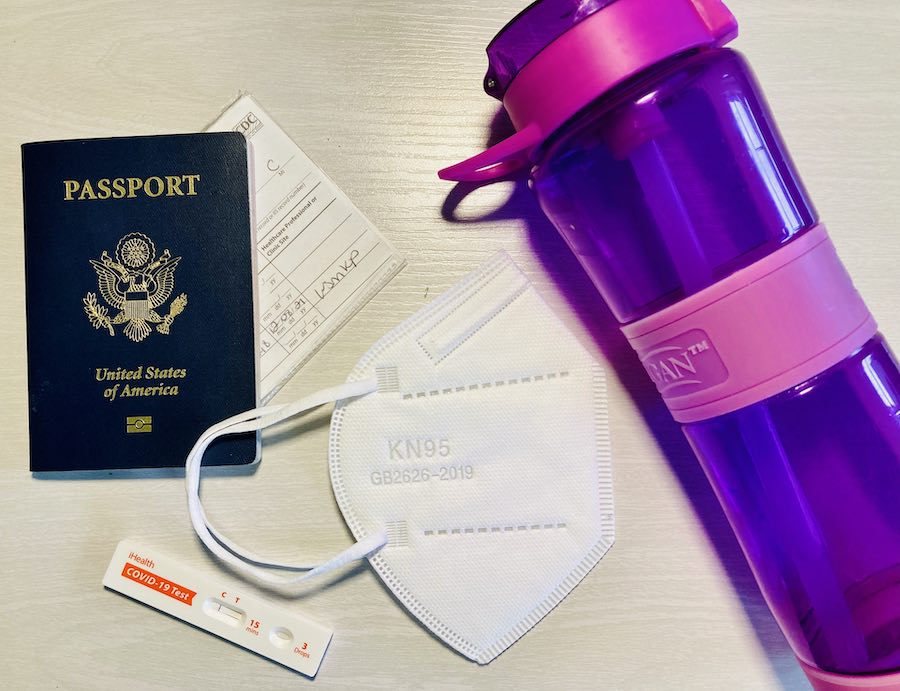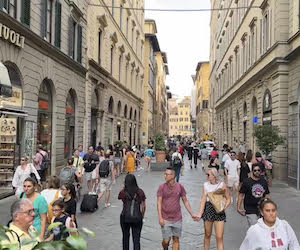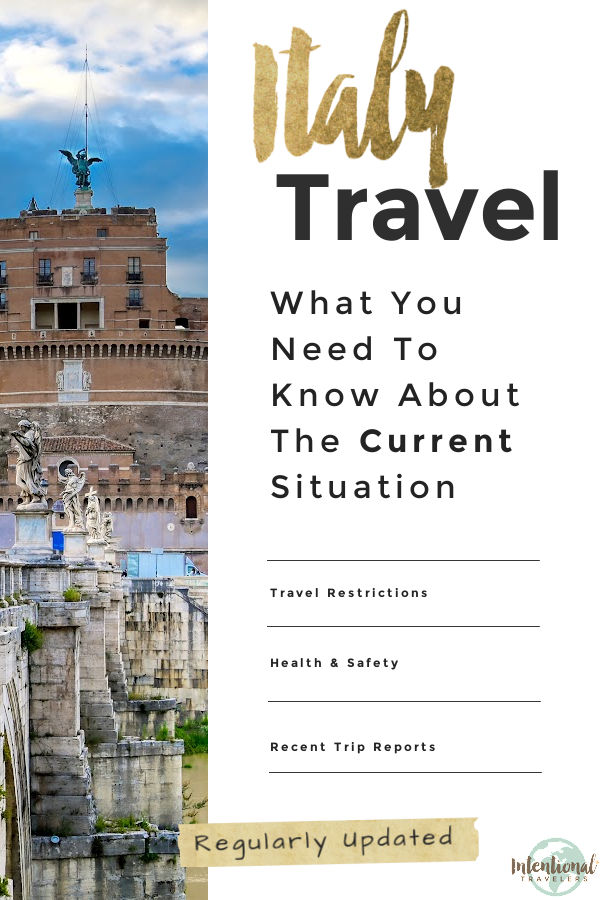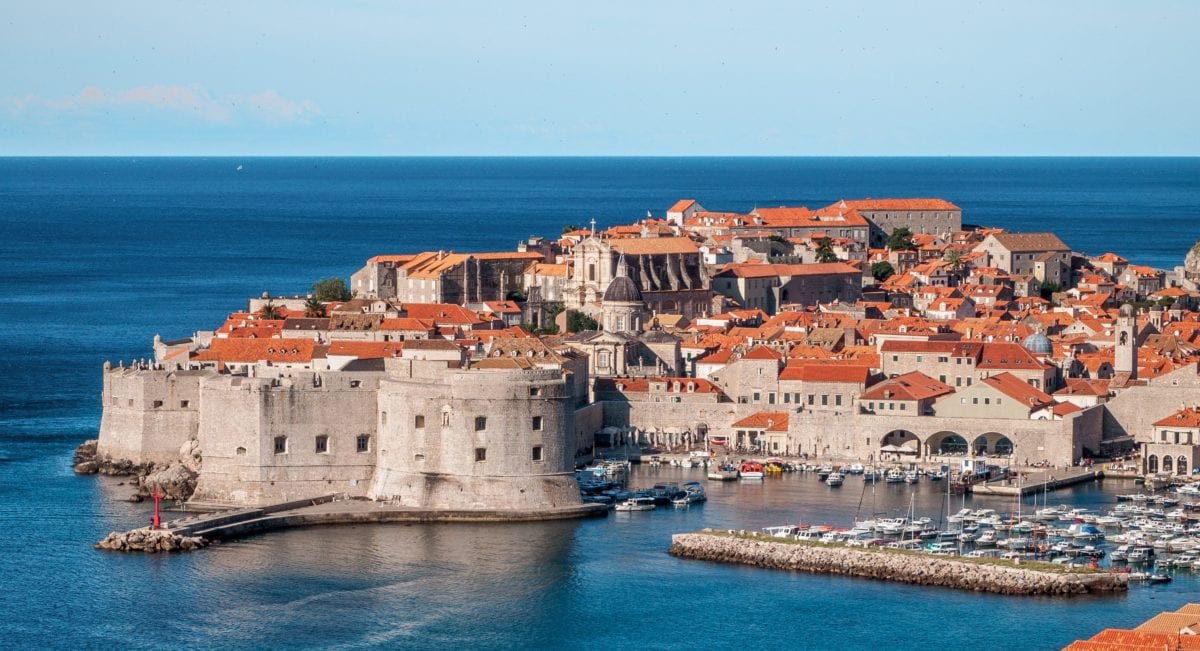Italy travel restrictions Winter 2022-23: What travelers need to know
At Intentional Travelers, we believe travel can be transformational. That’s why we want to help you travel confidently, safely, and responsibly. With ever-changing travel restrictions and concerns surrounding COVID-19, our goal is to help you make informed decisions about where, when, and how to travel in this new world of ours.
Italy has a special place in our hearts, and we finally returned in Fall 2022. This post about Italy travel in 2022 is periodically updated with official Italy travel restrictions, requirements and guidance.
As restrictions vary based on the traveler’s citizenship, we will focus primarily on rules affecting U.S. citizens.
At the end of the post, we share on-the-ground perspectives from local residents and travelers to Italy so you’ll get a true sense of what to expect.
Last update: November 1, 2022. Originally published: July 2020.
Table of Contents
Can US citizens travel to Italy? Can I travel to Italy right now?
Italy is open to US citizens who are traveling for any reason, including tourism, under the following protocols.
As of June 1st 2022, all travelers, including US citizens are no longer required to show a vaccination, recovery, or test certificate upon arrival to Italy. All travelers can enter Italy without quarantine.
As of May 1, a self-declaration form (dPLF) is no longer required. (Link sponsored by Natvisa.)
The same entry rules apply to Americans transiting through, or departing from, countries other than the United States. See details here.
Many Italy travel restrictions have been lifted as of May 1 for activities inside the country. See regional restrictions here and regional zone classifications here.
Quarantine rules in Italy: What happens if I get Covid?
American travelers are not required to quarantine upon arrival in Italy.
Foreign tourists who test positive for Covid while in Italy need to self-isolate immediately and contact regional authorities.
Quarantine is required for those who get Covid for 5-14 days, depending on the specifics of the case. Visitors must remain inside for the duration of the quarantine period, avoiding contact with anyone else.
Travelers may sometimes be able to remain in their hotel but some will have to quarantine at a government-sponsored facility. It is not guaranteed that groups traveling together will be able to quarantine in the same location.
Travelers may be required to cover costs of quarantine accommodations.
The quarantine can end after being symptom-free for three days and taking an official PCR test with negative result.
Italy Green Pass Requirements to Enter Restaurants, Attractions and Large Events
You might be wondering: Do I need a vaccine certificate or Covid test to enter restaurants and attractions in Italy?
As of May 1, Italy’s green pass (basic or super green pass) is no longer required to access restaurants, businesses, public transport, or participate in certain activities.
However, the Super Green Pass is still temporarily required for anyone age 12 and older to access hospitals or care homes.
Can Americans travel to Italy in November 2022? Can US citizens travel to Italy this Winter?
Travel to Italy in November is open. Read on for details and check back for updates.
What is it like to fly to Italy FCO or CIA Rome International Airport right now? In Rome, body temperature checks through thermo scanners may be taken at the entrance of the airports. The airports sanitize their spaces daily.
Check with your airline about current mask requirements on board.
Do Americans have to quarantine when traveling to Italy? No. Quarantine is not required for American travelers.
Quarantine is mandatory for those who test positive for Covid in Italy. See details above.
Does Italy check COVID-19 symptoms of incoming travelers? Body temperature may be scanned in the airports for inbound and outbound travelers.
Does Italy require a negative Covid 19 test for American travelers? A negative Covid test is no longer required to enter Italy.
Does Italy require a proof of Coronavirus vaccine for American travelers? Proof of Coronavirus vaccine is no longer required to enter Italy.
Do I still need to provide a negative Covid test or quarantine if I have been vaccinated? Neither proof of vaccination, negative test, nor quarantine are required to travel to Italy.
Is a booster shot required for travel to Italy? A booster shot is no longer required to enter Italy.
However, a booster shot is needed for the US vaccination card to be considered a valid Green Pass to enter healthcare settings while in Italy. See Green Pass Requirements above.
What Covid testing options are available for travelers in Italy? PCR and antigen tests are available for U.S. citizens and visitors in Italy. Antigen tests cost approximately 20-30 euros while PCR tests cost approximately $70.
Individuals in Italy can get a Covid test from the following:
What healthcare options are available to travelers in Italy who get the virus? Tourists and visitors may access Italian health care and emergency services by paying out of pocket or with privately purchased travelers’ insurance. Tourists can also contact the Italian Covid hotline at 1500 (free toll number).
For travel insurance that covers Covid, check out Nomad Insurance by Safety Wing >
What service businesses and restaurants are open in Italy? Businesses and restaurants in Italy can operate depending on their zone classification. Currently, all regions in Italy are in “white”.
In white zones (lowest case numbers), bars, restaurants and all other establishments are open. Both indoor and outdoor dining are allowed.
Are face masks required in Italy? As of October 2022, wearing of masks in Italy is no longer mandatory except in healthcare settings.
Are buses and trains running in Italy? Public transportation is available throughout Italy at normal capacity. Masks are no longer required on buses, trains, etc.
Will Italy impose new Covid restrictions? What’s next is difficult to predict. Historically, most countries impose COVID-19 restrictions when strains on the health care system might become unsustainable.
How has the Coronavirus impacted Italy?
Italy was the first country in Europe affected by COVID-19 and was hit hard by the outbreak, requiring strict lock downs. Another large spike in cases occurred at the end of October 2020. A nationwide state of emergency continued through 2022.
Italy’s economy, which includes a large tourism sector, has faced its deepest recession in history. More than 200,000 tourism-related jobs were discontinued in Italy by the end of 2021– accounting for a massive shortage of workers in the country.
In May 2021, Italy formally opened its borders to international travelers from select countries to revive tourism. In June, Italy eased its restrictions for international travelers, then tightened somewhat due to the Delta variant and Omicron variant.
Italy’s state of emergency ended on March 31, 2022.
Italy obtains its vaccines via an EU procurement program. On December 27, 2020, Italy vaccinated the first residents against COVID-19. Currently, three quarters of Italians are fully vaccinated.
For the current situation in Italy, including: total COVID-19 positive cases; daily number of cases in Italy; and COVID-19 recovery rates in Italy, please see the statistics here.
What should you pack for safely traveling in Italy?
Face Masks – Face coverings are recommended in public spaces and required in healthcare settings.
Find N95 masks at Bona Fide > or designer options at Vida >
Medicine – Bring enough prescription and over-the-counter medication for your entire trip to avoid trips to the clinic.
Vaccine Card Holder – Protect that paper CDC card when traveling abroad (if your country doesn’t offer a digital version).
Get a simple plastic protector > or Vegan leather clippable > or Leather passport + card combo holder >
Covid self-test – The most studied rapid antigen self-test with FDA emergency authorization. NOT valid to enter countries. Use for your own peace of mind.
Order from CVS > or Walmart >
Sealed water bottle – Make sure your reusable water bottle has a lid that’s not exposed to the air. We use one of each of the following:
Shop insulated water bottles with protective lid >
Shop water bottles with purification filter and protective lid >
✈️ Travel insurance that covers Covid – We’ve started using Nomad Insurance by Safety Wing for affordable evacuation, international medical, and trip coverage.
What do Italian locals and recent travelers say about visiting Italy now?
What is it like to visit Italy right now? It’s our goal to provide regular updates here from real people on the ground, to help potential visitors know what to expect.
The following are subjective opinions only. Official travel guidance can be found above.
October 18 2022 -Michelle, Intentional Travelers: “Italy’s tourism feels back in full force and daily life has resumed as normal. Some people wear masks in grocery stores, trains, or other public areas but not many. On the train back to Rome airport, we saw staff sanitizing handrails in all the train cars. Lines at FCO airport seemed typical, and we passed through check-in, security and customs relatively quickly (25 minutes) on a weekday morning. We didn’t have to show any Covid documents, only passports.”

Florence crowds Sept 2022
September 2022 – Michelle, Intentional Travelers: “We flew into Florence, Italy and took trains through Tuscany in September. To enter Italy, we only needed our passports. Air Dolomiti airlines required masks on the flight.
The Florence airport tram into town had signs that masks were required but maybe 50% of people were masked. Around Florence, it is as busy as ever and highly recommended to make reservations for big attractions in advance. Masks were still required on the regional trains in Italy, enforced by staff and audio announcements. Otherwise, tourism does seem back to normal.”
June 3, 2022 – S.M, American digital nomad – “I flew today to Rome from Croatia. They didn’t ask for anything covid related. No test or vax cards. But we had to wear N95 mask on the plane, that’s it.”
May 2022 – Lyndsay at thepurposelylost.com: “I’ve been living in Italy and exploring the country for six months now, and the past few days were the busiest I’ve seen the cities! As the weather gets warmer, we’re expecting an uptick in tourism, which is definitely what I’ve encountered so far. Tourists are eager to experience la dolce vita again!
Although you don’t need to wear a mask walking around outside, masks are still required on public transportation like busses, metros, and trains, and highly encouraged for all inside spaces like restaurants and shops. You’ll even find a mix of people wearing masks at public outdoor events.”
March 24, 2022 – Heather American/Italian dual citizen: “I flew into Rome and then proceeded to take several trains and a bus to get to a tiny village in Abruzzo where I will be living for the next five months. Masks are required inside all buildings, and most buildings have signs indicating you need to show a Super Green Pass for entrance. Trains and buses did check for my Super Green Pass and my CDC card showing my booster was accepted readily.
Italians are still taking things pretty serious, regarding masks, etc.”
March 2, 2022 – Sarah Wilson of Life Part 2 and Beyond, British visitor: “I’m in Florence for 10 days learning Italian. I was surprised how many tourists were here over the weekend. Queues were long to many of the major sites. They do check your Green Pass every time you enter a tourist attraction, and restaurant. Some shops also insist on seeing your Green Pass but not all. Masks are being worn inside but not needed outdoors.
There are plenty of pharmacies, many offer COVID testing or the rapid antigen tests. All the pharmacists in a city like Florence speak great English. To reduce waiting in line, I recommend booking attraction tickets online in advance.”
Candice of Mom in Italy, Permanent Resident: “It’s a nice time to visit because you can visit places like the center of Florence and its museums without any crowds.
We’ve also been visiting smaller villages like Pienza, Montepulciano, and San Gimignano, but they’re a little too empty. Almost all shops and restaurants are closed, due to the lack of local visitors. For anyone thinking of coming to Italy right now, I’d stick to the bigger cities, where you’re guaranteed to find things open and still full of Italian ‘vita.’
Throughout the entire pandemic, I’ve been impressed by the cooperation of Italians. People here wear masks when/where required and for the most part, respect the rules. Visitors need to follow the rules too – for example, if you don’t have the Green Pass here, you can’t sit down in an indoor restaurant. Owners don’t distinguish between locals and tourists – everyone has to have their Green Pass scanned or checked.
It’s easy to get tested in Italy – there are private clinics and you can also get tested in pharmacies. You can also get English translations easily. It’s not a great time to come to Italy if you aren’t vaccinated (or have proof of recovery from COVID within the last 6 months). Pretty much anything you’d want to do as a tourist right now requires the Green Pass.
We haven’t found any long lines or crowds, although I expect there will be an influx of visitors in the spring because Italy’s precautions help make it a less risky destination and people are ready to come back to Italia!”
January 2022 – Claudia of Strictly Rome, Italian resident: “All attractions and places of interest for tourists are currently open in Italy. Visits to restaurants typically start with the staff coming to the table to check your “green pass” (the Italian vaccination card). Much like locals, tourists are required to show proof of vaccination or of having recovered from Covid to access attractions, restaurants, hotels and transport – including trains and local / city buses.
Everyone in Italy follows the rules, wearing masks wherever required and showing their vaccination card to access public places, restaurants, attractions, transportation and the like. Antigen tests are available at any pharmacy, best if upon booking and depending on the city and region in Italy there may be a line to get tested. Access to health care remains free for everyone on Italian territory, including visitors. You will be significantly better off making restaurant reservations as with Covid restrictions and social distancing availability for tables in popular tourist destinations may be limited.”
December 2021 – Or of My Path in the World, Israeli traveler: “I flew to Turin for a one week leisure trip in December 2021. I felt very safe in Turin as everything was well organized and it seemed like the locals were determined to live “normally” again.
Everyone follows the current restrictions, and some people even wear masks outdoors though it’s not mandatory. You can’t enter a museum or a restaurant without your Green Pass being scanned (unless you’re sitting outside), and some attractions require a reservation in advance because you need to pick a specific timeslot for your visit. There are quite a few places for covid tests, and a PCR test for your flight back home will cost you about 70 Euros.”
November 30, 2021 – Morgan Fielder, Crave the Planet, E.U. expat: “It’s so great and easy to get reservations at awesome restaurants with fewer tourists. The airports in Italy have gotten more efficient and travel has been extremely easy since August if you are vaccinated and keeping your mask on appropriately.
Yes, people follow the rules. Access is good to hospitals and if there’s any hint of problems, then businesses and events have gone to only letting in vaccinated or recovered people. Contract tracing is done via app when you go inside a venue or restaurant.”
September 20, 2021 – Sarah Wilson, British expat in Malta: “I was in northern Italy at the beginning of September for two weeks and now I’m in Sicily until the end of the month. The locals are very welcoming. It’s been a tough time for many businesses in Italy, so they are very happy to receive tourists. I literally had Rome to myself, so if you enjoy travelling without the crowds, now is the time to visit.
To enter any restaurant, museum or tourist site, you do have to show your vaccine certificate. Some places like the restaurants in Lake Como also asked for your name and phone number. Masks are worn on all public transport and indoors and majority comply. Sicily has recently turned yellow which means masks are supposed to be worn indoors and outdoors – very few wear them outdoors – it’s too hot.”

Photo by Abigail
August 2021 – Abigail, American traveler: “I went to Italy for a weekend. I felt safe and all of the stores were open. There was a green pass that people used to dine indoors, however since I’m a US Citizen I did not have one. Instead I showed my vaccination card, and it was asked for at every establishment. They did not ask for the Covid pass for public transport for Venice or Milan during my stay. For sit down restaurants, they wouldn’t let you in the door if you could not show vaccination. I did see a lot of seats for outdoor dining everywhere I went though.”
August 2021 – Caroline A., South African/Italian visitor: “My husband, 7 year old son, 4 year old daughter and I are in Rome for three months for an adventure as we have dual citizenship.
Tourists are very much welcome in Rome at the moment although museums are requiring the green pass to enter. Since we are not vaccinated, we have been getting tested for entering museums, which lasts 48 hours. Testing is widely accessible. Most attractions are open for visits with covid protocols in place. There is a festive mood in the air as many people take their vacation over this time. It is wonderful not to have to wear a mask outside.”

Photo credit: Kathryn K.
July 2021 – Kathryn, American Traveler: “I flew from Spain to Naples, Italy and stayed 2 days in Positano, 2 days in Sorrento, and 4 days in Rome.
The locals were happy to have patrons in their cafes and restaurants. We had several people tell us how happy they are to see return of tourism.
All public transportation was running as it would pre-pandemic (masks always required). We took planes, trains, taxis, boats and buses with no restrictions.
Some restaurants required you to write down name, phone number, country of origin for contact tracing. Otherwise, no restrictions for outdoor dining and tables were quite close to each other as you would typically experience in Europe. Indoor dining often had more space between tables to allow for social distancing.
In Rome, there were quite a few walk-up COVID testing tents throughout the city to use if needed. Rome sights were much less crowded than what I’ve experienced past summers.
All major tourist sites were open. They offered both advance tickets and walk-up (usually wouldn’t be possible due to large numbers of tourists in the summer, but with less tourists this year it was possible to purchase day-of tickets). They had temperature checks at most major sites and required masks if indoors.”
June 2021 – Alexander and Cynthia, Travel your Memories, Dutch visitors: “We flew to Rome and visited for 4 days. After Rome we travelled to Florence for 2 days. Because you can do many activities outside, Italy is prefect to travel to at the moment.
The population pays very close attention to the guidelines of COVID. All sights have been adjusted accordingly. Only a maximum number of people are allowed in the shops (depending on the size). If you get cold symptoms, you can go to a test street. For major sights it is important to book your ticket in advance because you have to fix a time slot.”
May 2021 – Sarah, Benvenuti Arts, American: “I have a visa as I’m here to teach at a University, and traveling into Italy felt joyful! The crew on the flight were so happy to see us all, and there were only about 30 passengers on the plane. The customs officials were very nice and the people doing COVID-testing in the airport were very friendly.
While the rules, as read, seemed more strict than the US, I’m noticing people’s interpretation of those rules is just as scattered as in my country. I happened to arrive right when they reopened after the Easter lockdown, and people seem to be thrilled to be outside. We wear masks in all public areas, and there is no indoor dining, so in general it feels safe. But I am finding myself a bit overwhelmed by crowded areas, like places where students hang out. That’ll take some time to get used to again!
I would say, if someone is traveling soon, be respectful and be overprepared. Rules were changing weekly in the lead up to my visit, so I have so much documentation printed that I haven’t needed. Everything takes a bit more preparation than you might be used to in Italy, too. Some restaurants require reservations. Museums are open, but with timed, pre-reserved tickets. There is no indoor dining. There’s a curfew. I am usually loose with my planning when I travel, but am doing more of it just because it’s required.
But the food is amazing, the people are lovely, and the city is beautiful, so even with some adaptations, it’s amazing to be here!”
April 2021 – Chicca, Cooking in Tuscany, Italian resident: “We have been living a lockdown life since October – I have to say we’ve got so use to it. But just these days our prime minister has announced to relax some of the strict coronavirus measures starting April 26. The vaccination plans are rolling out quite consistently to have the majority of the population vaccinated by this summer.
I read here and there that maybe borders will be opening first to Europeans and then to Americans. We don’t know when but, yes, I start dreaming of having visitors again.”

Photo credit: Clotilde
January 2021 – Clotilde, A Princess Travelling with Twins, Italian living abroad: “I flew to Rome, with my husband and our twins over the Christmas period for 10 days to visit family.
People working in the tourist sector are really welcoming and try their best to respect, and make customer respect, the rules and regulations. They have been suffering a lot from the lack of tourists and all the imposed restrictions, so they are happy to see tourists coming back but other people are more cautious.
News of the new variants of the virus have particularly made people more alert. The biggest issue when travelling to Italy right now is the rules change really quickly, the country can ban specific countries without warning as happened over Christmas with people coming from the UK.
On top of that, each Italian region is defined by a colour depending on the level of the infection rate. This reflects also in services opening times that change unexpectedly and often forget to update their websites or search engines. For example you could be stranded at the airport wondering what to do as the rental car office where you booked your vehicle has closed and the curfew time is approaching, as happened to us!“
September 2020. Rebecca Ann Hughes, journalist – permanent resident of Venice: “Tourist numbers in Italy have been low all summer. For those who come to visit, they are seeing popular tourist destinations as never before, but many businesses are struggling. Locals whose work is fed by tourism are eager to welcome back visitors but many of them, along with those who do not work in the tourism sector, are pushing for a change in tourism.
Particularly in Venice, they want visitors who travel “slow”, who are respectful, and who interact with the community. This includes following COVID regulations imposed by local councils and the government.
Recently, a tourist on a vaporetto (waterbus) in Venice refused to wear a mask, angering locals and causing a fight to break out. Visitors should be well prepared to follow the regulations in Italy, even if they differ from their home country.
Most tourist attractions, public transport, restaurants, bars and other amenities are open and functioning as normal, albeit with social distancing rules and the obligation to wear a mask. It is possible that some tourist attractions will require advanced booking and may have longer queues if the venue is taking temperatures upon entry.
Visitors may often have their temperature taken when entering a restaurant. When entering a building or getting on public transport, use hand sanitiser if it is provided. Testing booths have been set up in many airports and visitors can download a contact tracing app for Italy.”

August 2020. Audrey – Traveler, E.U. citizen: “Tuscany was very opened to seeing travelers. While some local traditions were either canceled or toned down quite a bit, the villages are still charming to visit, boutiques are open for business and bars and restaurants are more than happy to see you.
It’s even advised to book, at least, the day before any larger attraction that you might want to visit in order to be able to get in. The floors of the Siena Duomo were just unveiled while we were there, typically we wouldn’t have gotten in if we had just showed up.
We drove to Tuscany from France and were not controlled what so ever. People tend to be comfortable with masks and in many places we saw masked faces mostly.
We once were offered to leave an email in a guestbook to be contacted in case of an outbreak in this restaurant but that’s it. Hydroalcoholic gel is available everywhere.”
Planning a trip to Italy?
If you have questions or updates about travel to Italy during the Coronavirus crisis or post-pandemic, please let us know in the comments below.
~ Pin this post for later or share with friends ~

Disclaimer:
Please note, travel restrictions change frequently. Readers must take responsibility for verifying information through official sources like the State Department and CDC, in respect to their specific situations. No responsibility can be accepted by Intentional Travelers for action or inaction as a result of information provided through IntentionalTravelers.com. Any information provided here is issued as general information only.
Michelle and her husband quit their traditional jobs in 2011 to serve as Peace Corps Volunteers. They have been location-independent digital nomads since 2014, running a freelance web services business while they explore new places. She is author of the book, An Intentional Travelers Guide to Unconventional Budget Accommodations: Creative Ways to Save Money on Transformational Travel. Her writing has also been featured on International Living, Transitions Abroad, Small Planet Studio, The Art of Non-Conformity, and more.
When Will Americans Be Able to Travel to Europe Again?
This post contains references to products from one or more of our advertisers. We may receive compensation when you click on links to those products. The content on this page is accurate as of the posting date; however, some of the offers mentioned may have expired. For more information check out our Advertising Disclosure.
Back in March 2020, nearly all travel between the U.S. and the European Union (EU) was shut down as countries around the world closed their borders to non-essential travel to limit the spread of COVID-19. A year later, travelers are still left wondering: When will Americans be able to go to Europe again?
For months, travelers from America were banned from entering much of Europe, as the European Union restricted foreign visitors to just a handful of countries with the pandemic under wraps – and the U.S. never made the cut. But now the tables have turned: As vaccinations gain steam in the U.S. and travel slowly rebounds, Europe is struggling with a sluggish vaccination campaign and a third wave of COVID-19 cases that have forced many major cities back into lockdown.
Yet there’s hope. On Wednesday, the European Union Commission unveiled its rumored plan for a “digital green certificate” that will allow travelers to prove their vaccination status for entry. While the emphasis is on allowing Europeans to travel freely across the continent, Bloomberg reports it will also provide a pathway for outsiders to eventually visit, too.
But the timing is uncertain – at least for most of Europe. Meanwhile, tourism-hungry Iceland is preparing to throw open its borders this week to all vaccinated travelers. Other European countries like Portugal and Greece are suggesting they’ll open up for travel with or without the European Union’s blessing.
So what does it all mean?
A Digital Green Pass? Europe’s Vaccination Passport
Your proof of vaccination could soon become the most powerful card in your wallet.
Across the globe, countries see proof of vaccination as the linchpin to resuming international travel. And Europe is no exception.
Wednesday’s proposal would set up a system dubbed the “digital green certificate” that allows travelers to easily prove their vaccination status, show a recent negative COVID-19 test, or prove their recovery from COVID-19 along with some basic personal data like name and date of birth. It sets standards for countries across the EU, from Portugal to Poland, to eventually lift lockdowns and implement the certificate system to resume accepting tourists from around the continent.

Wednesday’s emphasis was on clearing the way for travel throughout Europe – not for allowing outsiders from the U.S. or across the globe to return. But the digital green certificate could provide a pathway to allowing Americans and other foreigners back into Europe.
An FAQ on the new system says the EU could eventually decide that other countries’ vaccination certificates pass muster.
“Then, such third country certificates would be accepted under the same conditions as Digital Green Certificates,” according to the commission.
Non-EU member countries like the United Kingdom and Ireland continue to set their own entry requirements and travel restrictions independently. Both still currently require all visitors to test negative before departure and quarantine upon arrival. Others like Iceland, Switzerland, Norway, and Liechtenstein are expected to adopt the green certificate system.
But When?
That’s the big question.
European Union Commission President Ursula von der Leyen said the commission aims to have the digital green certificate up and running in time for a summer travel season. First things first, the proposal must get passed, then implemented by individual countries across the continent.

Bloomberg reports that a draft proposal calls to have the system in place by mid-June. But that doesn’t mean Americans (and others) will be allowed to visit later this spring.
That likely hinges on the COVID-19 situation in Europe. Countries across the continent are grappling with a third wave of cases, exacerbated by faster-spreading variants of the virus.
If you’re wondering when will Americans be able to travel to France and other major tourism areas in Europe, case counts in Italy, France, Germany, and elsewhere are back on the rise, hitting their highest points across Europe since early February, according to The Guardian.
A Glimmer of Hope
The longer borders remain closed, the tougher it will be for economies to rebound. Many European countries rely on tourism – and American tourism, in particular.
Tourism makes up 25% of Greece’s GDP. In France, it makes up 9.7% of its GDP, accounting for 2.9 million jobs. And in Spain, the tourism sector is the third-largest contributor to the economy. Put simply, Europe needs tourism to come back.
Some countries have made clear they can’t go on much longer without tourism.
European Countries Vaccinated Travelers Can Visit
Officials in Greece say they hope to welcome back tourists from across the globe by mid-May, Reuters reports – with or without the EU’s blessing. A week after suggesting an opening was imminent, Iceland announced it would open to tourists from around the globe who can provide proof of vaccination starting March 18 – just a day in advance.

But we’ve seen how that’s played out before. Both countries had planned to open up last summer only to back away under threat of consequences from the European Union.
And it’s not all trending that way. Croatia was one of the few EU members that allowed American travelers last year, requiring proof of a negative COVID-19 test taken within 48 hours. But the country shut down nearly all international travel in October and hasn’t said when that will change.

Bottom Line
Where can U.S. citizens travel to in Europe? Between vaccinations at home and abroad, new digital systems, and a pandemic that isn’t over yet, there is so much up in the air. The next few months will be critical in determining whether Americans can return to Europe as soon as this summer.
But don’t give up hope. Europe (and the rest of the world) will need tourism. Let’s hope our world’s leaders can get us all on the right track, and figure out a way for us to safely open up soon.
Stop overpaying for travel!
Get our daily email for the latest in travel, flight deals, and how to save on your next trip.
Erica Kamrowski
Erica, Mrs. TT, joined her husband Jared at Thrifty Traveler in 2019 after 10 years in the wine business. She studied abroad in France in college and has since visited 27 countries.
Editorial Disclaimer: Opinions expressed here are the author’s alone, not those of any bank, credit card issuer, airlines or hotel chain, and have not been reviewed, approved or otherwise endorsed by any of these entities.
Disclaimer: The responses below are not provided or commissioned by the bank advertiser. Responses have not been reviewed, approved or otherwise endorsed by the bank advertiser. It is not the bank advertiser’s responsibility to ensure all posts and/or questions are answered.
16 Responses
I know it’s useless to ask you questions, since you don’t answer them…However, just in case you read comments and decide to explain your math in this statement: “the U.S. is averaging about 46,025 new cases per day – or just over 200 new cases per 100,000 residents ”
Because 46,025 cases for 330 millions (that’s how many Americans there are) translates into about 14 cases per 100,000 residents.
We almost always answer questions – and correct stories when we are wrong. And you are correct, we flubbed the math there: We were looking at case counts per 100,000 residents over 14-day periods (because that’s what the EU looks at) but did not spell that out for the U.S. case counts.
Thanks, we’ve updated the story!
European travel . What’s wrong with us?? 200,000 people dead and we are worried about tourism to Europe. This is what’s wrong with the country. Let’s stop the virus first and then worry about vacations and traveling. We are so spoiled .
You would think two super powers ( EU and USA) in the world could figure out a way to allow tourism to once again to begin in the EU and the United States of America. Cornea virus tests and temperature checks at airports would stop people with the Virus from entering each country. There is a safe way for everyone to travel again. I believe this is more of a political matter and not so much a virus matter. The EU has done more harm to their economy by not permitting Americans into Europe which actually helped the USA economy. Most Americans traveled throughout the in USA sense they couldn’t travel abroad. That’s is actually what President Trump wanted Americans to do.
The USA should be treated as individual states, not as a whole. Many states have complied with the mask wearing, social distancing and so on, whereas other states do not comply and make the good states look bad because of it. I live in Connecticut and there is no way I would travel in the US, especially to covid hot spots such as Texas, Florida, New York , California and Illinois. It is not safe. However, we can’t leave the country because very few countries will let us travel because they include all states as the US and don’t look at the individual numbers from states. We are presently around 3% and less daily, where as many states are 10% and over. I’m willing to wear masks and social distance. I have also been vaccinated with Moderna.
I’m inclined to agree with Kenneth. There are relatively safe ways to resume travel. It gets complex and there are a number of possibilities, but one bad prospect is different stains arising in different regions & due to isolation creating even greater risk. When a country, such as the US, achieves herd immunity from one strain it then becomes at risk for a 2nd wave from a different strain – and that 2nd strain WILL eventually hit us.
That said, I really appreciate the article & travel insights, but I agree the math is wrong. We’ve been running closer to 12/100k lately. Also new cases/day isn’t the critical number. This can be due to testing numbers. We have done 77 million tests to date – approaching 25% of our population & a greater % than any European country. New cases per 100k is not an unreasonable metric for travel, but percent tested should also be factored in. France, for ex., has only tested 1 in 10 of it’s population, so it will miss many asymptomatic or mildly symptomatic people.
It’s a shame politics gets injected into this, but I guess that’s reality. The metric here is deaths/million & we are in line with most countries & certainly better off than some European countries. I’ll just say that I didn’t vote for Trump but have followed closely day-by-day (it’s my job to know), and I fail to see how anyone could have done better under identical circumstances, given what we knew at the time. Even Dr. Fauci said in Feb. that Americans need not be concerned. The CDC messed up with their testing criteria & we soon knew this wasn’t going to be contained. Hindsight is always 20/20 but I think our country has done about as good a job as can be expected.
PS: Contact tracing in a nation so spread out is possible only on a local level. You cannot contact trace someone on a NY subway with thousands of people getting on & off and going in a thousand directions.
The numbers cited are in relation to the criteria set by the EU. They are looking at the # of cases per 100,000 for 14 days. At the time of publishing the average per 100,000 was 14 which is just under 200 cases for 14 days.
Yes, I understand that, and as mentioned it’s not an entirely unreasonable metric. However, beyond that, apples-to-apples should be the comparison. If one country does 1/10th the testing we don’t know the true number of new cases. It gets a bit complex. We use a variety of different tests in the US in order to meet demand & some have notoriously high numbers of false positives. Beyond that, even deaths are calculated differently. In the US we count every death of a patient with covid as a covid death, even if the cause of death is unrelated. Why? Because it pays. Code a record for covid & the govt pays big time. Code for ventilator use & get an extra $40,000. Yep, $40k.
It seems to me that we need an ad hoc committee composed of a virologist, a representative of the travel industry and a representative of the airline industry to develop a protocol that would reduce the danger of flying to Europe to that of not flying to Europe. For example, one could be tested at 10 days and 3 days before flying. One needs a test with few false positives and a rapid readoutl
Why don’t these countries do testing as you enter each country, thereby allowing tourists to go the way they want to go after a day or so of quarantining. I would be more then happy to have a test before I head out of Boston for the UK and then have one when I get there, and anything else I would need. I live in a state where we obey the social distancing and mask rules and our covid level is about 1%. I don’t think those of us doing our share should be punished because of the idiots who refuse to social distance or wear masks. I’ve had 2 Covid tests for medical purposes, negative both times. We need a covid test for every procedure here in CT. I need my annual mental health vacation to England badly. There has got to be a way these governments could come through. I am more then happy to help out their economy by spending money there.
Not everyone who wants to go from the US to Europe fits the profile of “tourist.” Some of us have homes there and want to go for more than a two week stay in a hotel. It would be great if they could open up for different types of entry, though I admit this would be hard to manage.
Agree with Lisa 100%. I’m a post-grad and I was supposed to move to Paris in June on a permanent job contract. The visa centers have told me that I have to wait for the borders to open like everyone else. This makes no sense to me.
If I was going for pleasure, I’d get it, but I’m not – so I don’t… as long as I follow all the precautions, take the test 72 hours before departure, wear the mask till I get to my apartment…?
Good article. A couple of sentences that need some work:
“On Wednesday, the for a “digital green certificate” that will allow travelers to prove their vaccination status for entry”
“An FAQ on the new system says the EU could eventually decide that other countries’ vaccination certificates.”
Whoops, something got messed up with our editing. We’ve fixed it – thanks for pointing it out!
When Will I Be Able to Travel to Europe?
If you’re wondering when you’ll be able to travel to Europe again, the answer changes daily. The good news is; due to the success of the COVID vaccination program, international travel to Europe may begin as soon as May 17 – the date set by the UK government for international travel to/from England.
Keep in mind the UK and the EU (now separate due to Brexit as of 12/31/20) have different entry requirements.
As of today, international passengers into most European countries will require a negative COVID-19 test result within the past 72 hours and/or a 10-14 day quarantine on entry depending on their country of orgin. Source.

When Can I Travel to Europe Again?
1. Travel within each European country
- Check before you travel as the situation changes on a daily basis. Here’s a good source for current travel restrictions country by country.
2. Travel within Europe and the UK
- Travel may be permitted between some countries in the EU (or Schengen zone) without the need for a 14 day quarantine.
- Here is the official list of travel corridors from the UK government website.
3. Travel between Europe and the US
- The complete list of country travel restrictions for Coronavirus Source
- US travelers are allowed into England with a 10 day quarantine on arrival. As of January 18, 2021 a negative test for COVID-19 taken within 72 hours of arrival will also be required. Note Wales, Northern Ireland and Scotland may have different guidelines. This is expected to change when guidelines are reviewed May 10.
Traveling to the UK & Europe from USA
The US Dept of State’s health advisory is still currently Global level 3, meaning reconsider travel to the UK. Source.
Expect rules to change for travel into the Great Britain as of May 17. Guidance from the UK government is expect on May 10 regarding which countries fall into red, amber or green categories. International arrivals into the UK will need to follow these guidelines.
ENGLAND
- What you need to know if your flight is into or out of London’s Heathrow Airport
- What you need to know if your flight is into or out of London’s Gatwick Airport
- National Express coach service is operating
- National Rail trains may be on a reduced schedule as are TFL London underground trains
- Check this essential guidance about what to expect for hotel, restaurant and visitor attractions opening in England.
- Most stores and shops (food, hardware, chemist/drug) are open but require wearing a mask until June 21.
- Masks are still required on all public transportation, buses, trains and taxis, but that may change June 21.
SCOTLAND AND NORTHERN IRELAND
- Check before travel. Scotland and Northern Ireland may have different guidelines than England.
- You may not be able to cross the border into Scotland or Ireland from England.
EUROPE
- As of April 25, the EU (European Union) is considering allowing American travelers who have been fully vaccinated to travel to Europe this summer. Travel within the EU is also expected to be open to Americans this summer also.
- Dates have not been set, but stay tuned. Summer starts officially on June 21.
- France has also indicated it’s ready to open it’s borders to Americans by the summer.

Cobbled streets of Arles, France
Traveling to the USA from UK & Europe
Until further notice, due to presidential proclamation; travelers who have been to these areas in the last 14 days may not be allowed into the US or if they are they will be subject to enhanced screening:
- United Kingdom, including England, Ireland, Scotland and Wales
- Republic of Ireland
- European Union – Schengen zone
- China
- Iran
- Brazil
This presidential proclamation hasn’t changed under the Biden administration and unfortunately this guidance hasn’t been updated since Feb. 2021. Here’s further guidance from the CDC on international travel during COVID-19
US citizens and permanent residents of the US are still permitted to return to the US. Here’s the latest TSA advice for what to expect when flying and also FAQs for flying.
U.S. citizens in the United Kingdom are subject to the ‘Stay at Home’ regulations. You should not travel abroad unless it is permitted under the rules. This means you may not go on holiday. If you are visiting the UK, you may return home to the United States.
As of September 14, travelers into the US are no longer being directed to 15 regional airports. Source This is a welcome change for anyone who’s seeking to return to the US without the inconvenience of flying into an airport far from home.
My Best Advice
- The Tripit app, which I’ve found invaluable on past trips; now offers access to airline-specific COVID-19 guidance within the app.
- If you’re a US resident who wants to travel to Europe, wait until you’ve had both vaccine shots.
- Get travel insurance but be aware travel companies may exclude COVID-19 from their coverage. You can still be covered for trip cancellation and ordinary medical expenses.
- If you book and pay for a trip through a reputable tour company, you should be reimbursed if your trip is cancelled due to future travel restrictions. Some tour companies are holding off offering tours until guidance on restrictions is clear.
- My advice? I’m as antsy as you are to get traveling but I’ll wait to consider booking a holiday until government guidance is clear about what is permitted and what’s required to travel.
If you’re thinking of traveling from the US to the UK and Europe in the near future keep in mind these general guidelines.
- You’re allowed to travel into Europe including France, Italy and Spain or the Schengen (most Europe countries including Norway and Iceland) area for up to 90 days without a visa. Your US passport needs to have at least 3 months left once you return to the US. So if your visit to Europe is for 30 days, you’d need 4 months left on your passport.
If you’re ready to relocate, my moving abroad checklist can help you get started. For complete advice on traveling into Heathrow or Gatwick airports and central London, check out my advice here. Please leave any questions in the comments below. Stay safe and see you soon.
Source https://intentionaltravelers.com/italy-travel-restrictions/
Source https://thriftytraveler.com/news/travel/when-will-americans-be-allowed-to-travel-to-europe-again/
Source https://www.hipoverfifty.com/when-will-i-be-able-to-travel-to-europe-again/